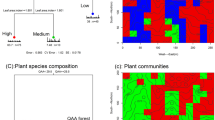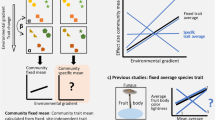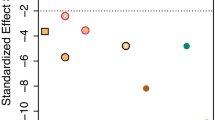Abstract
A graphical method of analyzing the spatial pattern of macrofungal species in beech forests is described. Species response curves are investigated both from the qualitative (presence/absence) and from the quantitative (log fruit-body number) variation of each species. The approach was applied to 49 macrofungal species, of which 34 were significantly related to certain pattern models. Macrofungi exhibit characteristic response curves along a one-dimensional mull/mor gradient. Also species with a relatively scarce occurrence have the potential to show significant patterns. Graphical tests of the qualitative and quantitative variation were used to provide a better description of the probability of a species to be present on certain sites.
Similar content being viewed by others
References
Arnolds, E. 1981. Ecology and coenology of macrofungi in grasslands and moist heathlands in Drenthe, the Netherlands. Part. I. Introduction and synecology. Bibl. Mycol. 83: 1–407.
Austin, M.P. 1987. Models for the analysis of species' response to environmental gradients. Vegetatio 69: 35–45.
Austin, M.P., Cunningham, R.B. & Fleming, P.M. 1984. New approaches to direct gradient analysis using environmental scalars and statistical eurve-fitting procedures. Vegetatio 55: 11–27.
Barkman, J.J. 1976. Algemene inleiding tot de oecologie en sociologie van macrofungi. Coolia 19: 57–66.
Bohus, G. & Babos, M. 1960. Coenology of terricolous macrofungi of deciduous forests. Bot. Jahrb. 80: 1–100.
Campbell, B.M. 1978. Similarity coefficients for classifying relevés. Vegetatio 37: 101–109.
Cotter, H.V.T. & Bills, G.F. 1985. Comparison of spatial patterns of sexual and vegetative states of Bolitinellus merulioides. Trans. Br. Mycol. Soc. 85: 520–524.
Dixon, W.J. 1981. BMDP statistical software. University California Press, Los Angeles.
Gauch, H.G. & Whittaker, R.H., 1972. Coenocline simulation. Ecology 53: 446–551.
Goff, F.G. 1975. Comparison of species ordination resulting from alternative indices of interspecific association and different numbers of included species. Vegetatio 31: 1–14.
Goodall, D.W. & Johnson, R.W. 1982. Non-linear ordination in several dimensions. Vegetatio 48: 197–208.
Goodall, D.W. & Johnson, R.W. 1987. Maximum-likelihood ordination-some improvements and further tests. Vegetatio 73: 3–12.
Guminska, B. 1962. Mycoflora of beech forest of Rabsztyn and Maciejowa (in Polish). Monogr. Bot. 13: 11–85.
Hansen, P.A. 1988. Prediction of macrofungal occurrence in Swedish beech forests from soil and litter variable models. Vegetatio 78: 31–44.
Höfler, K. 1954. Ueber Pilzaspekte. Vegetatio 5–6: 373–380.
Jansen, E. & deWit, T. 1978. Veranderingen in de verspreiding van de Cantharel in Nederland. Coolia 21: 117–123.
Jensén, S. 1978. Influences of transformation of cover values on classification and ordination of lake vegetation. Vegetatio 37: 19–31.
Johnson, R.W. & Goodall, D.W. 1979. A maximum-likelihood approach to non-linear ordination. Vegetatio 41: 133–142.
Lambert, J.M. & Dale, M.B. 1964. The use of statistics in phytosociology. Adv. Ecol. Res. 2: 59–99.
Orlóci, L. 1966. Geometric models in ecology: I. The theory and application of some ordination methods. J. Ecol. 54: 193–215.
Orlóci, L. 1968. Definitions of structure in multivariate phytosociological samples. Vegetatio 15: 281–291.
Orlóci, L. & Mukkattu, M.M. 1972. The effect of species number and type of data on the resemblance structure of a phytosociological collection. J. Ecol. 61: 37–46.
Sadowska, B. 1973. Preliminary evaluation of the productivity of fungi (Agaricales and Gasteromycetes) on the Kazum meadow (in Polish). Acta Mycol. 9: 91–100.
Smartt, P.F.M., Meacock, S.E. & Lambert, J.M. 1976. Investigations into the properties of quantitative vegetational data. II. Further data comparisons. J. Ecol. 64: 41–78.
Strahler, A.H. 1975. Continuous and binary (presence or absence) measurement of vegetation: a comparison for eastern forest data. Proc. Assoc. Am. Geogr. 7: 233–237.
Strahler, A.H. 1977. Response of woody species to site factors in Maryland, USA: Evaluation of sampling plans and continuous and binary measurement techniques. Vegetatio 35: 1–19.
Swan, J.M.A. 1970. An examination of some ordination problems by use of simulated vegetation data. Ecology 51: 89–102.
terBraak, C.J.F. & Looman, W.N. 1986. Weighted averaging, logistic regression and the Gaussian response model. Vegetatio 65: 3–11.
Tyler, G. 1984. Macrofungi of Swedish beech forest. Department of Plant Ecology, University of Lund, Sweden.
Tyler, G. 1985. Macrofungal flora of Swedish beech forest related to soil organic matter and acidity characteristics. For. Ecol. Manage. 10: 10–13.
van derMaarel, E. 1979. Transformation of cover-abundance values in phytosociology and its effects on community similarity. Vegetatio 39: 97–114.
Weir, D.A. & Wilson, J.B. 1987. Micro-pattern in an area of New Zealand alpine vegetation. Vegetatio 73: 81–88.
Werger, M.J.A., Louppen, J.M.W. & Eppink, J.H.M. 1983. Species performance and vegetation boundaries along an environmental gradient. Vegetatio 52: 141–150.
Williams, W.T. & Dale, M.B. 1962. Partition correlation matrices for heterogeneous quantitative data. Nature Lond. 196: 602.
Williams, W.T. 1973. Partition of information: The CENTPERC problem. Austr. J. Bot. 21: 277–281.
Woodwell, G.M. 1967. Radiation and the patterns of nature. Science 156: 461–470.
Author information
Authors and Affiliations
Rights and permissions
About this article
Cite this article
Hansen, P.A. Species response curves of macrofungi along a mull/mor gradient in Swedish beech forests. Vegetatio 82, 69–78 (1989). https://doi.org/10.1007/BF00217984
Accepted:
Issue Date:
DOI: https://doi.org/10.1007/BF00217984




